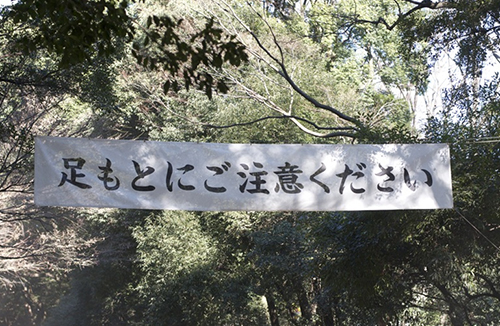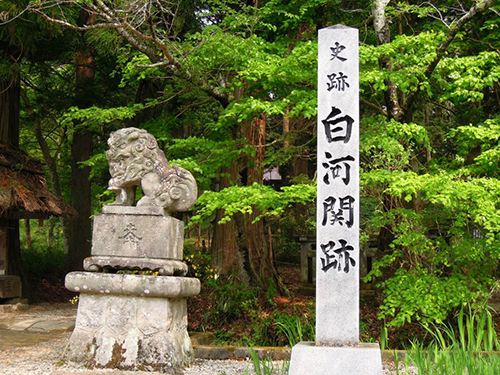157. The "Foot" Radical: 足
For many of us the foot is an afterthought. Perhaps that's because it couldn't be farther from the brain, particularly from the eyes. Or maybe we devalue feet because they're often perceived as dirty.
But feet are essential. They are our foundations. They connect us to the earth, the surface we share with many other life forms. Massage therapists and those who work with reflexology put a premium on the feet. So does my dog trainer. She told me that the paw is where the most tension accumulates in a dog, so I should give my critters frequent paw massages!
In the kanji world, the foot is actually a bit less valuable, in that the "foot" radical 足 is on duty in just 11 Joyo kanji. But several of those kanji pop up quite often, increasing the importance of our radical.
Photo Credit: Eve Kushner
Traditional Japanese socks have a separate compartment for the big toe. Such socks are known as 足袋 (たび). In this ateji term, the usual sounds of the kanji don't matter. But what does matter is the wonderful breakdown foot + bag; a sock is a bag for the feet!
The writing is faint on the labels, so it's tough to make out 文化足袋. The word 文化 (ぶんか) means "culture." I thought 文化足袋 might be a brand name. Apparently, though, the term refers to socks with tabi-shaped toe compartments but not the openings at the heels that traditional tabi have.
The 足 Kanji and 足 Radical
The autonomous kanji 足 has a range of definitions:
足 (foot, leg; step; to walk; counter for pairs of footwear; suffice; "foot" radical)
Henshall says that 足 is a pictograph combining a "kneecap" (口) with a "foot" (the bottom four strokes). All together these shapes mean "(lower) leg," he says.
In the 足 kanji (which has five Joyo readings, including あし), the radical is 足, also pronounced あし.
Just as the autonomous 足 kanji can mean "foot" or "leg," the radical can have either name in English. We'll go with "foot."
By the way, this radical has seven strokes.

Photo Credit: Christopher Acheson
The sign begins with the 足 kanji (and therefore with our radical!):
足もとにご注意ください
Please watch your step.
足もと (あしもと: one's step);
注意 (ちゅうい: being careful)
Incidentally, one can render 足もと entirely in kanji in these ways:
足下, which literally means "underfoot," breaking down as foot + under
足元, which doesn't literally mean "origin (元) of the foot" but instead breaks down as foot + where something is
The "Foot" Radical on the Left
Of the 11 Joyo kanji with 足 as an on-duty radical, the 足 kanji stands alone from a design perspective. The other 10 characters feature this radical on the left, as these three examples do:
践 (1495: to carry out)
跳 (1595: to jump)
踊 (1880: dance)
On the left side of a kanji, the radical changes shape. The radical name changes, too, becoming あしへん (足編). The 編 means "left-side radical."
Photo Credit: Eve Kushner
In the city of Kobe, another sign starts with our radical! It heads off this word:
路地裏 (ろじうら: back street; back alley; off-street) alley (1st 2 kanji) + back
The restaurant name translates as "Back Alley Italian"!
The kanji of interest here is 路 (415: route).
The Footprint of the 足 Radical
A foot is unquestionably tangible and visible. But it has direct links to footprints, which are hardly there at all. So it is that the 足 radical brings footprint-related definitions into two kanji meaning "traces." Consider these etymologies:
跡 (1485: trace; ruins)
Kanjigen says that the 亦 on the right side represents "armpits with a chest's width between them." But we need to drop our sights quite a bit because the 足 radical means "foot." Thus, 跡 symbolizes footprints, with one shape (of the feet) repeated at regular intervals.
踪 (2055: traces, footprints; whereabouts)
The 踪 consists of 足 (foot) + 宗 (to repeat many times), according to Kanjigen. That is, 踪 represents "repeating footprints." Meanwhile, Henshall says in his newer edition that 蹤 is the original shape of the character, breaking down as 足 (foot, leg) + 從 (the Traditional Chinese form of 従, “follow”). He says that 蹤 therefore means “footprints, tracks, remains.”
By the way, 足 combines with 跡 in this fun word:
足跡 (あしあと: (1) footprints; (2) record of web page visitors (e.g., on social networking sites)) foot + traces
Ah, there's the digital footprint people are always mentioning. Though there are no actual feet involved online, this web activity somehow involves a double helping of the 足 radical!

Photo Credit: Christopher Acheson
When you walk down the aisle of a train or plane, you look up at an angle (at least I do because I'm quite short!) to read the sorts of labels you see here: 通路側 (つうろがわ: aisle) and 窓側 (まどがわ: window). Thanks to the "foot" radical in 路 (415: route) and therefore in 通路側, a foot hovers near the ceiling!
The Literal Use of the Feet
In other kanji, the 足 radical lends a sense of stepping, treading, kicking, leaping, and dancing. Here are two more etymologies, both from Henshall:
踏 (1657: to step on; be based on)
Our radical means "foot," and the right side means "to connect," also acting phonetically to express "to come into contact with." If a foot comes into contact with the ground, it produces the meaning of "treading" or "stepping on."
躍 (1860: to leap; be active)
The "foot" on the left combines with "bird's wings"! What a fantastic hybrid creature! The right-side component also acts phonetically to express "to leap" and probably "soaring high." Thus, the whole character means "to leap (with the legs)."

Photo Credit: Yoshikazu Kunugi
In one short sign we find two instances of our radical! Both times it's in 跡 (1485: trace; ruins), which appears with different yomi in these two words:
史跡 (しせき: historical landmark)
白河関跡 (しらかわのせきあと: site of the Shirakawa Barrier)
In the fifth century, people erected a barrier gate known as 白河の関 (しらかわのせき) between the rough-and-tumble, unconquered northern part of Honshu and the more “civilized” and urban Kanto region to the south. Shirakawa Barrier Park in Fukushima Prefecture (on Honshu) commemorates this barrier, particularly with a memorial stone that marks the place where the actual barrier is believed to have stood. (See essay 1731 on 碑 (inscribed stone monument; tombstone) for a photo of the memorial stone.)
No one knows the location of the barrier for sure because it eventually disintegrated to the degree that its ruins completely vanished.
